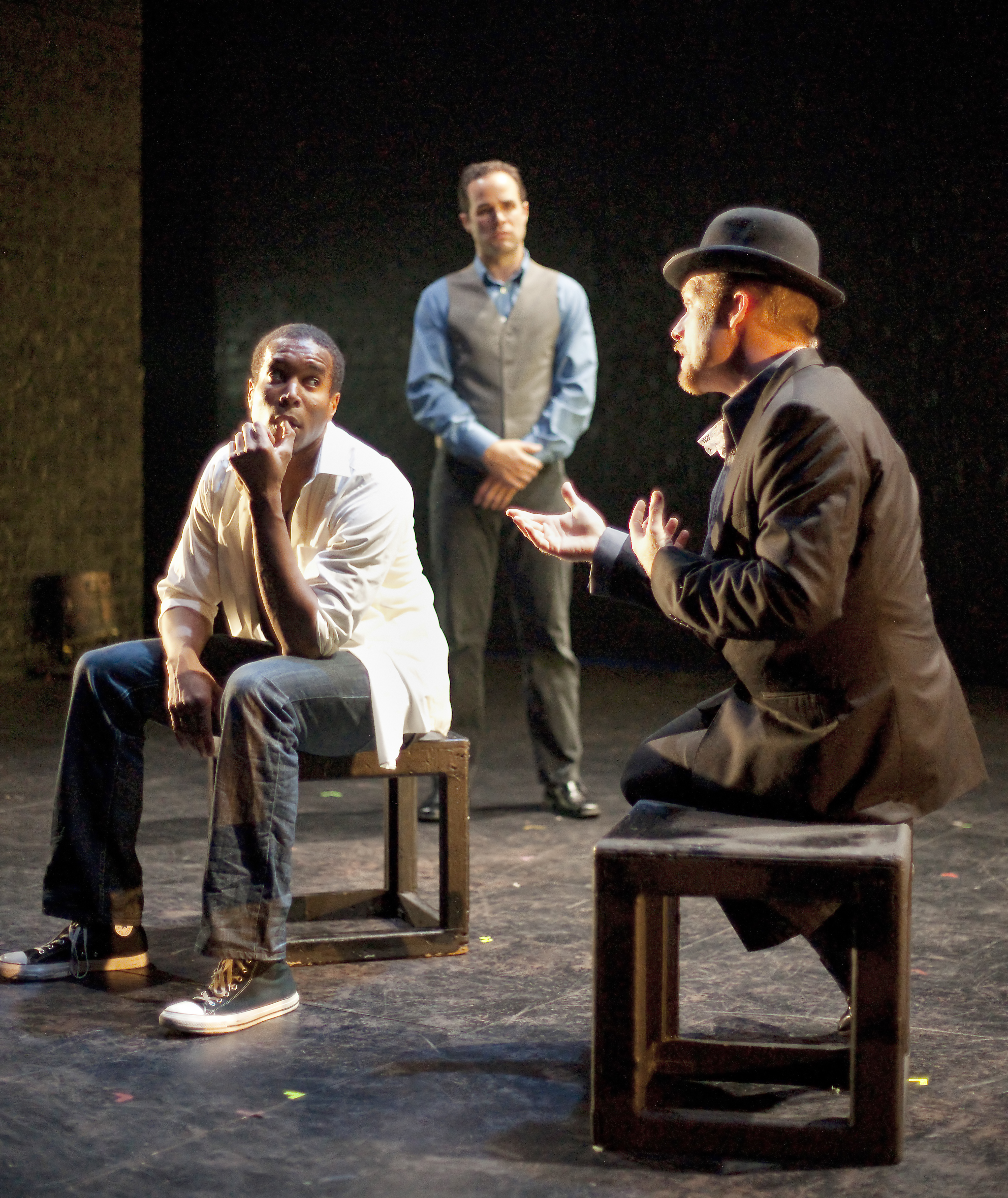Making ‘Hamlet’ relatable

Hamlet (Terrence Colby Clemons) (left) spars with Ostricke (Matthew Wrather) (right) over King Claudius’ wager with Laertes over a sporting duel. Horatio (Joseph Tower) (center) observes the mismatched banter with the wit-challenged messenger.
“Hamlet”
Friday, 7:30 p.m.
Macgowan Hall Little Theater, $7.75
By Michelle Soave
Nov. 4, 2010 1:14 a.m.
Just about everyone has been exposed to “Hamlet” at some point, whether by watching “The Lion King” or reading the play in an English class. The plot line is basic: King is murdered by brother, brother takes over throne, prince must revenge father’s death. While there are many different versions of the classic play, the UCLA Theater Department’s production will offer a modern take.
According to Professor Michael McLain, the director of the upcoming production of “Hamlet” by the theater department’s graduate students, Hamlet is a universally relatable character, particularly in his struggle to face the corruption of his world.
“No one gets through life without coming nose-to-nose with seemingly insuperable challenges, wrestling with destiny or the situation they’re given,” McLain said.
Taking McLain’s statement into consideration, “Hamlet” is an important play, and not just for its role as a foundational stone of Western culture. This particular production, aimed at college students, focuses on the relatable problems facing the title character.
“Hamlet” begins Friday at 7:30 p.m. in UCLA’s Little Theater in Macgowan Hall and runs through Nov. 20. It will also be featured at the Los Angeles Theater Center from Dec. 2 to Dec. 12.
“People will encounter a Shakespeare performance that seems relevant and modern and available, not overly academic or stuffy,” McLain said.
Even in a world of Facebook addicts and Starbucks junkies, this 400-year-old play is still relevant, according to McLain. It hasn’t been modernized like the “Romeo Juliet” that Leonardo DiCaprio starred in; it has been stripped down to emphasize the poetic language and the expressed ideas, particularly those dealing with morality and mortality.
“Shakespeare plays can be done, with good actors, almost in an empty room. It exists in the language and interactions between characters,” McLain said.
Though this play hasn’t been simplified so drastically, “Hamlet” will be less of a production than some of the department’s previous plays.
Costuming is simplified: There will be no elaborate hairstyling or makeup, and the costumes have a modern basis with added pieces suggestive of the time period.
“The styling is vague and casual. It’s … expressing the actors themselves and their mental state in the scene. We’re expressing the character instead of trying to create a silhouette,” said Daniella Cartun, a master’s of fine arts student in design for theater and entertainment media and the costume designer for “Hamlet.”
Rather than creating pieces that reflect the traditional medieval setting of “Hamlet,” Cartun allowed the actors to bring in their own clothes. Using modern clothes as a base, Cartun added pieces, like a cloak or crown, that capture ideas such as the era of the play and the social rank of the characters.
“It was a challenge trying to create cohesion with all the pieces that we have. … We really wanted to bring the colors into the same world … to convey (the psychology) in the color palette, to mimic Hamlet’s craziness,” Cartun said.
Likewise, the sound design mimics the psychological issues in “Hamlet.” McLain and sound designer Rosalyn Rice decided to use abstract sounds to bridge between scenes ““ using people whispering, a clock ticking and a bucket falling down a well.
“We ended up with bridges composed of natural sounds that became larger, almost as if they belonged to a dream or nightmare. … They seemed more at home, seemed to suit the psychological experience of what goes on,” McLain said.
With such diluted sound, costume and scenic design, this version of “Hamlet” focuses on the relationships and ideas of the characters.
“We’re trying to discover the truth in the characters and bring them to life again,” said Jane Bacon, a third-year graduate student in acting.
In order to do this, Bacon interpreted her character Gertrude, Hamlet’s mother and queen of Denmark, in her portrayal of the character’s life prior to the first scene.
“What we attempted to do is approach the play not as an historical artifact, but as something that is very much alive through both what’s in (“Hamlet”) and its connection to our lives,” McLain said. “We’re getting to the heart of the matter. It’s about us, not something that ended in the 1600s. The issues and problems and human experience in the play continue.”


